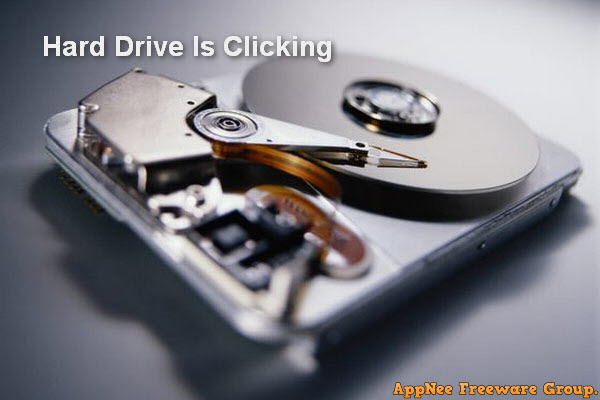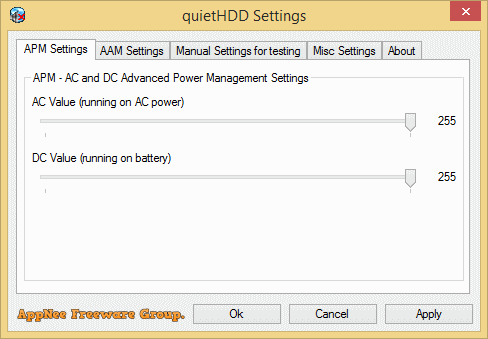| Ⅰ | This article along with all titles and tags are the original content of AppNee. All rights reserved. To repost or reproduce, you must add an explicit footnote along with the URL to this article! |
| Ⅱ | Any manual or automated whole-website collecting/crawling behaviors are strictly prohibited. |
| Ⅲ | Any resources shared on AppNee are limited to personal study and research only, any form of commercial behaviors are strictly prohibited. Otherwise, you may receive a variety of copyright complaints and have to deal with them by yourself. |
| Ⅳ | Before using (especially downloading) any resources shared by AppNee, please first go to read our F.A.Q. page more or less. Otherwise, please bear all the consequences by yourself. |
| This work is licensed under a Creative Commons Attribution-NonCommercial-ShareAlike 4.0 International License. |

If your laptop has both HDD and SSD installed at the same time (for example: use SSD to load and run the operating system, yet use HDD for storage purpose), then you’ve probably encountered and endured the bother that HDD makes a clatter every few seconds (that’s usually 1, 3, or 10 seconds). Especially if you’re using Western Digital, Seagate or Hitachi’s hard drive products.
First, you don’t have to doubt that this means your hard drive is broken; Second, don’t worry about that this situation will cause damage to your hard drive. Instead, it’s a feature originally designed by disk manufacturers to save energy and reduce hardware loss (of course, now it becomes a bug due to obsolescence) – by retracting/homing the head of hard drive when it has not read or written data for more than a few seconds (usually that’s 3), and minimizing the rotational speed of HDD or even stop it.
As a result, when your OS needs to read/write the hard drive again, you’ll hear a noticeable click along with a lag of 1~3 seconds (because the hard drive needs to recovery speed in this period of time, and the head needs to go back to the position where it left last time to read and write data). And almost everyone does not like to or even can not bear to listen to the hard drive click every few seconds in a quiet environment. Besides, if you look at the status analysis data of this hard drive, you’ll see a jump of its C1 value – although it doesn’t make any sense.

Perhaps you have tried countless methods, and AppNee has tried more than just these ones:
- Set the virtual memory (i.e.: the pagefile.sys file) on HDD, or turn off the virtual memory completely
- Install anti-virus software to HDD
- Modify the “Power Options” to “High performance”
- Change the Hard disk’s “Turn off hard disk after” to “Never”
- Update or even uninstall the power management driver
- Reverse the position of SSD and HDD (one in the optical drive slot, and the other in the original hard drive slot)
- Replace the optical drive hard disk bracket with another brand
- Toggle a switch that may be on the hard drive holder
- Replace the HDD with a brand-new one
- Write a batch file to access (read/write) the hard disk unlimitedly
- And whatever method you can think of, search for
- ….
But I can tell you doubtlessly – none of them can solve the problem perfectly, even do not have any effect at all. Instead, you only need a tiny app to instantly settle this matter – quietHDD (the successor of eeeHDD, written in PureBasic, developed by Joern Koerner and originally for ASUS Laptops/Netbooks). The time your run this software – your hard disk is permanently quiet, then the whole world is quiet, meanwhile your mood is calm too, and your spirit can be highly concentrated, will not be harassed every few seconds any more!
In the end, believe me, quietHDD is the only effective solution you can find on the Internet right now to solve the problem that HDD constantly makes noise in the combined use of “SSD+ HDD”. In essence, it works the same way as using CrystalDiskInfo to: “turn off APM and AAM” + “start with Windows” + “always run in the background”. But obviously the former is much simpler and more efficient, because it was made for this!
// Key Features //
- Small (about 60 KB)
- Does not eat CPU time and uses a very small amout of RAM
- Functional and responsive but powerfull, GUI and non-GUI usage possibe through command line interface
- Modifies or disables the Advanced Power Management (APM) feature setting of the primary harddrive depending on powered and battery state
- Modifies the Automatic Acoustic Management (AAM) feature setting of the primary harddrive depending on powered and battery state
- Works with almost any modern PATA and SATA harddrive
- Compatibility: Windows 2000, Windows XP, Windows Server 200x, Windows Vista, Windows 7, 8, 8.1, 10
// About APM Feature //
The APM feature value controls after which time the R/W head should be parked to avoid possible headcrashes when the hdd is idle. After the heads has been parked, it also controls after which time the hdd spins down when still idle (i.e. the drive motor turns off). NOTE: All MTBF and power consumption values are for the Seagate Momentus 2.5” harddrive – other drives should be similar. The lower you set the APM value the more the hdd parks the heads and spins down.
Well, those both things seems to be a good thing. But unfortunately every HDD has a so called MTBF (Mean Time Before Failure). For the HDD head parking it is ~600,000 and in the first week my see counts ~10,000 loads/unloads! SpinUp/SpinDown count of MTBF is ~20,000. The other annoying thing is the noise that the head parking makes…
A APM Value below ~100 makes the head parking and spin down very often. MTBF would be reached quiet early (I personally prefer 255 on AC and DC). Parking the head does not really consume too much battery power so it should does make any difference. But a spin up after a spin down consumes about 1.0 amps! While running the hdd just consumes from 0.75 to 2.0 watts. (See Reference above).
// About AAM Feature //
The AAM value controls how fast (or slow) the head should be moved over the drive disks. This is another source of noise. You can notice less noise when using small values on heavy disk I/O. This feature does not consumes any less or more (measurable) power from battery. It just moves the head faster or slower.
// About Windows Power Settings //
Windows can control the hdd spin down too! In the Power settings control panel, you’ll find it the settings for controlling the harddisk power. I would always recommend to use Windows Power saving feature, since Windows knows best when all memory I/O buffers has been written to disk! quietHDD does not modifies any Windows settings in any way except you choose the “Disable suspend” option.
// Use Instructions //
- The topmost entry is just an info when HDD’s APM/AAM was last modified.
- Disable System Suspend is a switch to say Windows it should not enter any power saving mode. It’s quite useful when you are downloading large files, running long calculations or doing any other things and you do not want Windows to enter powersaving mode.
- Disable HD APM now just says the HDD to disable this feature. It will be also called automatically whenever Windows wakes up from suspend or hibernate
*** Place the application quietHDD.exe anywhere on your system and create a shortcut in your account’s Startup folder in order to make it auto startup:
- %appdata%\Microsoft\Windows\Start Menu\Programs\Startup\
// System Requirements //
This application requires administration rights. Sorry there is no other way to access the drives internal registers. If you use the pre-installed Windows XP Home Edition, the user account already should have the necessary rights. If your account has restricted rights you should start this application via runas or surun.
// Prompts //
- APM = Advanced Power Management
- AAM = Automatic Acoustic Management
- When idle, the drive wants to park the heads because the Advanced Power Management (APM) of the hard drive is activated by default every time the drive motor spins up after suspend. This APM park feature produces the really annoying sound. Now, whenever the system starts, wakes up from suspend or hibernate the drives APM is activated. The click sound comes back again and again. This little tool just sits in the sys-tray and will recognize when the system wakes up from suspend or hibernate and disable the drives APM feature. That’s all.
- There are pros and cons to everything. This way, your HDD doesn’t click any more, but your fan will keep spinning all the time. Because your hard drive keeps spinning and generating heat! That’s a bit more expensive than it used to be, and it’s more impact on hard disk life than before – even though it’s not that big deal.
- Fortunately, in addition to disabling the capabilities of APM and AAM with one click, quietHDD also allows manual adjustment of APM and AAM settings for AC and DC power, respectively, and allows to enable/disable the APM and AAM control in Misc Settings at any time.
- Do not just run the program and leave it alone. You need to right click on its system tray icon, enter “Settings/APM Settings“, set all values to 128, enter “AAM Settings“, set all values to 128, click ‘Apply‘, and click ‘Ok‘.
// Download URLs //
| License | Version | Download | Size |
| Freeware | v1.5 Build 250 Final |  |
24.7 KB |
(Homepage)
| If some download link is missing, and you do need it, just please send an email (along with post link and missing link) to remind us to reupload the missing file for you. And, give us some time to respond. | |
| If there is a password for an archive, it should be "appnee.com". | |
| Most of the reserved downloads (including the 32-bit version) can be requested to reupload via email. |